Project Management Assignment: Project Planning For Cibo Espresso In Perth
Question
Task:
Your task
Individually, you are required to prepare an eight-page project management plan for a company based on the assessment instructions below.
Project Management Assignment Description
The purpose of this individual assessment is to give students an opportunity to create an integrated project management plan that meets industry standards and objectives. In analysing the organisational factors that promote effective project management, students will also consider factors that may give rise to ethical compromises.
Assessment Instructions
Presume that you have just been employed by one of the companies listed below to manage an opening of a new setup in Perth.
Cibo Espresso
Aquabliss
Maggie’s Farm Shop
For the purposes of this assessment, you are to assume the setup in Perth will be an identical model and operations, with the location being entirely sustainable (without goods/services being shared between the two locations).
Within your research consider the size, location, and requirements of the new setup in Perth and make sure you identify the unique operational, management and procurement needs of the company you select. When considering your plan, think about the various operational and logistical needs of your chosen company to begin operations in Perth.
Answer
Introduction
This particular project management plan is mainly developed on the basis of the process of opening a new store of CIBO espresso in Perth. This report would focus on utilising the identical model of the operation for the considered organisation along with maintaining sustainability in the considered location. It would also signify the location requirement and size of the considered new setup across Perth along with ensuring the identification of the unique operational requirements which also include the procurement needs and management needs of the organisation. It would also provide the work breakdown structure, Gantt chart, scheduling flow chart and risk assessment matrix for the new setup in Perth.
Company Overview
Current Operations including standards and specifications
CIBO Espresso is an Italian coffee chain that established its business in Adelaide in 2000 (CIBO Espresso, 2022). The organisation is mainly developing its business to provide the Italian experience of coffee to the population of Australia. The organisation developed with the help of its four founders in which one Italian chef who develops the different main used to provide the culinary adventure, an artisan pasticciere, a handsome barista and one restaurant manager. All of the individuals have engaged to develop the entire environment of the organisation and by engaging all the four components, it develops the authentic Italian experience across Australia. It has been identified that the organisation maintained certain standards and specifications through which it provides its products and services across different locations in South Australia (CIBO Espresso, 2022). On the other hand, the specification provides the capability to maintain sustainability within its business while experiencing an Italian ambience.
Essential requirements for the move
The organisation has already expanded its business across different locations in South Australia while Victoria and Western Australia have no proper store of this organisation. CIBO Espresso has maintained its charm and attractive experience among all its stores across Australia (CIBO Espresso, 2022). Therefore it can be identified that the sustainability policy is one of the major factors while it focuses on moving to a new location for establishing an entire store by following the identical model and operation. Another major essential requirement for the organisation is the financial asset that needs to be secured while the organisation is focusing on shifting to a new location, specifically, in Perth.
Functional locations
The functional location for this particular project is mainly developed by focusing on Western Australia in which the capital of Western Australia, Perth can be considered. This particular location has offered some functionalities in which its economy is better than the other parts of Australia. The company can easily develop its business in this location because the Government of Western Australia encourages different businesses to develop its store across the city. Another major factor is that the time zone of the city is similar to Beijing, Hong Kong and Singapore, which makes it desirable to consider it as the destination for international delegates (Businesseventsperth.com, 2022). The functional location of Perth has also offered different brands and findings from the government by which it can implement different innovative technologies to provide a better experience to the customers across Western Australia.
Work Breakdown Structure
This section of the project plan is based on the work packages related to the project. It is essential to note that the plan is widely based on a new compound or business establishment for Cibo Espresso in Perth. The plan has been developed in a process that will allow the organisation to be self-sustained in Perth. Therefore, this section of the study is widely related to the corresponding ideas associated with project activities. Rianty, Latief and Riantini(2018) and Sutrisna, Ramanayaka and Goulding(2018) argue that a work breakdown structure (WBS) is rather important for project planning and overall success. This has been referred to in figure 1 of the project plan.
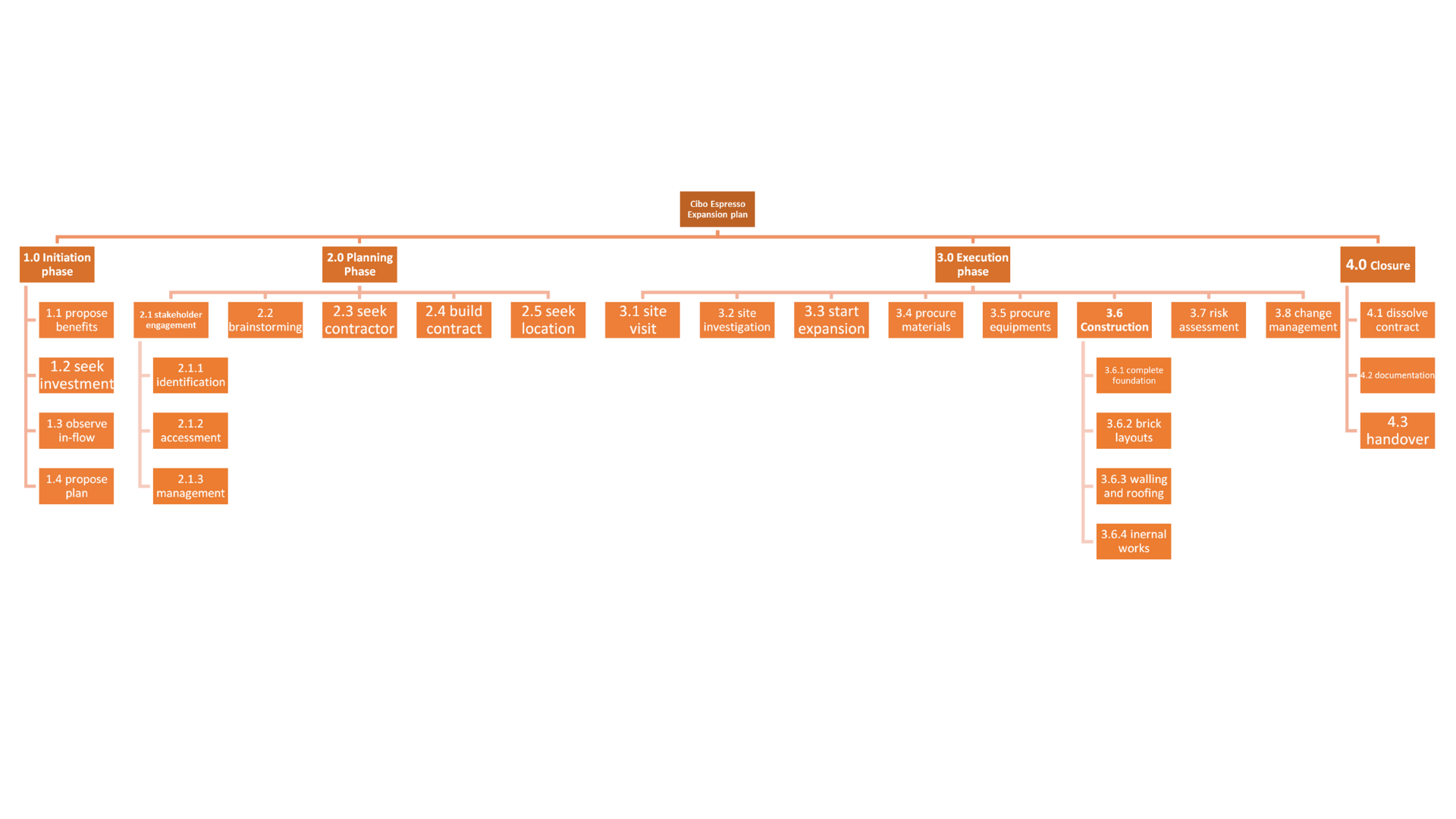
Figure 1: WBS
(Source: Generated by the researcher)
Based on the available data, it can be mentioned that WBS is related to the project's activities and deliverables. It can be mentioned that a WBS is often observed as one of the common and essential tools for project management. This is based on a step-based approach to complete viable and larger chunks of the project plan. Therefore, based on the representation in figure 1, it can be observed that the WBS is based on project deliverables and overall activities. This is further accountable to the idea that figure 1 relates to a “phase-based” illustration.It can be mentioned that the phase-based WBS is related to various levels of work that can be associated with project tasks. Hence, the project will be based on short-term objectives and goals. This is further accountable to the various levels of integration that promotes work. This is based on the relative influence of activities that account for relative deliverables and elements for the project. This may be further related to the idea that the WBS is related to identifying key elements and primary requirements for the project.
Gantt chart
This section of the study is widely based on the graphical illustration based on the project schedule. Bri and Mlinari (2018) argue that this is related to the overall demonstration for the project timeline that plays a potential idea for the project execution. Figure 2 relates to the Gantt chart associated with the project. It can be mentioned that a Gantt chart is widely used to show the activities within the project and schedule further activities. This will be based on the tasks and events related to the project and the graphical illustration against a time constraint. Through figure 2, it can be mentioned that the left side of the diagram will relate to the list of activities and the tasks within the project. However, the right side of the diagram or the chart relates to the duration and the relative position of the tasks. This is further accountable to the idea that the right part of the diagram is related to a histogram that relates to the overall ideas for the project through a single glance.
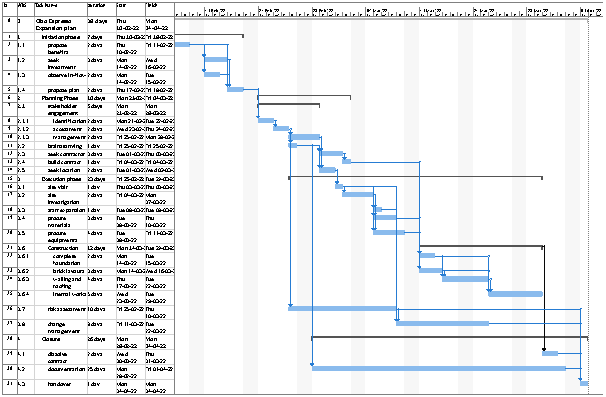
Figure 2: Gantt chart
(Source: Generated by the researcher using MS Project)
It is essential to note that the mentioned Gantt charts are currently used to track the projects. These are based on the progressing schedules based on the information and potential progress. This is further related to the organisation's various phases and related information that accounts for a deliberate proposition. Widyastuti, Irawan and Windarto(2019) mention this is based on the changing ideas and the current usage of Gantt charts based on project development. Therefore, it is essential to note that the mentioned illustration will be related to the project capabilities based on time-based parameters. This relates to the core ideas within the project. The overall schedule for the project can be observed through the mentioned tool.
Scheduling flowchart
Rahman, Chakrabortty and Ryan(2020) and Habibi, Barzinpour and Sadjadi(2018) argue that scheduling flowcharts are based on the overall schedules for the project. It is essential to note that the scheduling flowchart will be based on the optimal work packages related to the project. This is further accountable to the idea that a network diagram and critical path diagrams are a form of scheduling flowchart. Therefore, it can be mentioned that the overall ideas corresponding to a scheduling flowchart shown in the flowchart are related to time variance within the project.
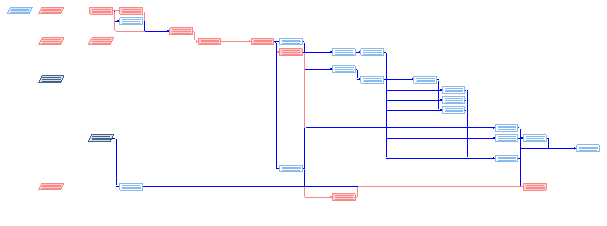
Figure 3: Network Diagram
(Source: Generated by the researcher using MS Project)
It is essential to note that a network diagram is based on the project managers' tool to track every element within a project. This is further accounts for the idea that the project elements are associated with the project's current state based on its activities. This is observed in figure 3, while figure 4 shows the critical path or the longest and the most suitable path to complete the project successfully. This shows the flow of activities based on project requirements. The fact that network diagrams and critical route diagrams are both types of scheduling flowcharts supports this claim. As a result, the overall principles that correspond to the scheduling flowchart illustrated in the flowchart are connected to project time variation.
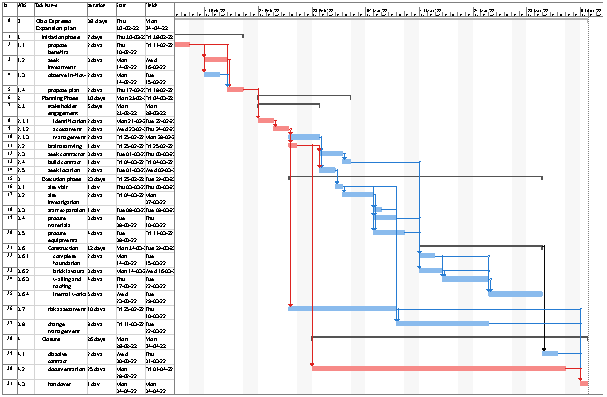
Figure 4: Critical Path
(Source: Generated by the researcher using MS Project)
Figure 4 also shows the idea that there are vivid chances for data observation and levelling based on the project schedule. Thus, it can be mentioned that a scheduling flowchart is widely related to the project schedule and shall not differ from the same. This allows various perspectives and diminutions for the project schedule. Hence, laying a concrete idea of data and activity flow for the mentioned project.
Risk assessment matrix
|
Risk ID |
Risk name |
Description |
Likelihood |
Severity |
Risk impact |
Risk mitigation |
|
1 |
Inappropriate choice of location |
The improper selection of a particular location can create a major risk which can impact on the profit generation of the business. It can also create a huge challenge to maintain the different facilities in products and services in a particular Store. |
6 |
5 |
30 |
While mitigating this type of risk, it is necessary to conduct improved market research by which it can properly depict the necessary factors which need to be considered while opening a new Store in a particular location (Okpala, Nnaji and Karakhan, 2020). It is also important to identify the necessary factors that can impact the market. |
|
2 |
Lack of financial resources |
The improper management of the financial resources can damage the overall project for which the store can experience a major impact on its budget. |
5 |
5 |
25 |
The process of mitigating this type of risk can be considered by effectively reviewing the financial budget before using any capital for the expenditure of the business (Ganbat, Chong and Liao, 2020). It would provide the necessary perception by which the store manager can acknowledge the specific areas in which the financial resources can be utilised in a proper manner to generate better profitability for the business. |
|
3 |
Lack of skilled employees |
It is one of the critical risks which can disturb the overall workflow of the business. The lack of skilled employees can damage the entire performance of the particular store as it would not be capable of fulfilling all the requirements of the customers. |
3 |
4 |
12 |
It is necessary to provide extensive training to the employees by which they can properly handle the pressure in the store along with providing necessary services to the customers by which the business organisation can achieve potential customer satisfaction that can help to increase its brand value. |
|
4 |
Reputation risk |
It is another risk factor that can damage the brand image of the organisation. It can be developed by improper behaviour of the employees and inappropriate work culture that is mainly regulated in the organisation. The dissatisfaction of the customers can create a reputation risk. |
2 |
5 |
10 |
The reputation risk can be mitigated by effectively using loyalty rewards and recommendation rewards. In the loyalty rewards, the customer who visits the store multiple times can achieve a probable discount while rewards can provide an effective discount to the individual who has been recommended by the other customers of the store (Thaler et al., 2019). |
|
5 |
Increased competition |
This is one of the important risks that can impact the business of CIBO Espresso. As the organisation decided to move its business to Perth, the organisation can experience immense competition because there are several other coffee shops that provide better services and products to the existing customer base. |
6 |
4 |
24 |
The increased competition can be mitigated by implementing a better pricing strategy. It would create attraction among the existing customer base which can be achieved as the target customer by the organisation (Nnaji et al., 2021). Another consideration can be applied by providing better offers in selecting different products by the customers which would help to mitigate the competition. |
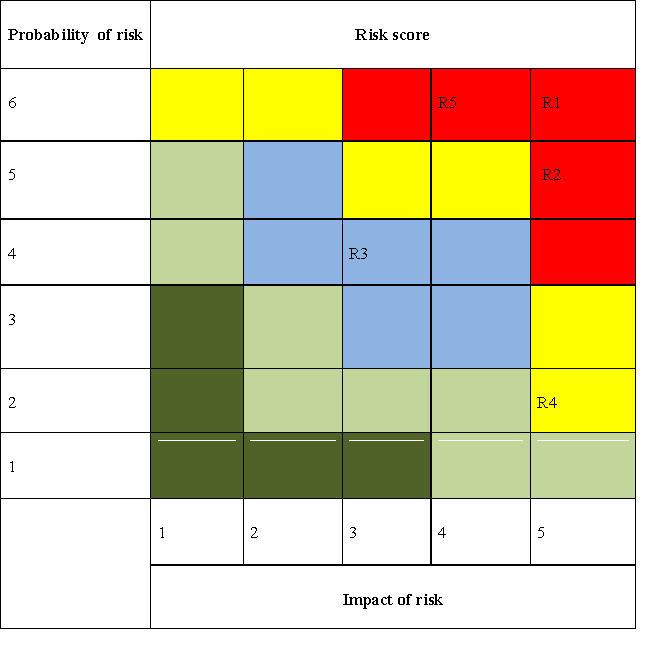
Conclusion
It can be safely concluded that the expansion project from Cibo Espresso has been related to its current operations and relative capabilities. However, it is essential to note that the project has varied parameters such as time constraints and work packages. These have been explained through the WBS, scheduling flowcharts and the Gantt chart within the project plan. This is further related to the detailed risk assessment matrix that demonstrates the relative risk factors within the project. However, valid mitigation strategies for the identified risks have been mentioned to generate optimal standards for the project, which will generate values for the project.
Reference List
Bri, M., and Mlinari, D. (2018). Tracking predictive Gantt chart for proactive rescheduling in stochastic resource constrained project scheduling. Journal of Information and Organizational Sciences, 42(2), 179-192. https://hrcak.srce.hr/file/310346
Businesseventsperth.com.(2022). Why Perth Available at: https://www.businesseventsperth.com/discover-western-australia/why-choose-perth/#:~:text=Powered%20by%20Translate-,Why%20choose%20Perth,host%20your%20next%20business%20event. (Accessed: 10 February 2022).
CIBO Espresso (2022). Available at: https://www.ciboespresso.com.au/about-us/ (Accessed: 10 February 2022). CIBO Espresso (2022). Available at: https://www.ciboespresso.com.au/stores/#!/south%20australia (Accessed: 10 February 2022). Ganbat, T., Chong, H.Y. and Liao, P.C., (2020). Mapping BIM uses for risk mitigation in international construction projects. Advances in Civil Engineering, 2020. https://www.hindawi.com/journals/ace/2020/5143879/
Habibi, F., Barzinpour, F., and Sadjadi, S. (2018). Resource-constrained project scheduling problem: review of past and recent developments. Journal of project management, 3(2), 55-88. http://m.growingscience.com/beta/jpm/2689-resource-constrained-project-scheduling-problem-review-of-past-and-recent-developments.html
Nnaji, C., Awolusi, I., Park, J. and Albert, A., (2021). Wearable sensing devices: towards the development of a personalized system for construction safety and health risk mitigation. Sensors, 21(3), p.682. https://www.mdpi.com/1424-8220/21/3/682/htm
Okpala, I., Nnaji, C. and Karakhan, A.A., (2020). Utilizing emerging technologies for construction safety risk mitigation. Practice Periodical on Structural Design and Construction, 25(2), p.04020002. https://d1wqtxts1xzle7.cloudfront.net/69795421/Okpala_et_al._2020_Utilizing_emerging_technologies_for_saefty_JCEM-with-cover-page-v2.pdfExpires=1644494217&Signature=AYXuPqM2iTIJZXIrs1~xDLAMzEFttbPxpUCJDt0Dh7TKM1cRS29KVrs5VEsMB8DzrXoXm7jaQt4rr945kX76wzUOD~Z4ZrXWWLVe3cJJe1IpXqtdvScoleOq9dMoeZ4Pp7qLyW~tkE8q9oGcMJ44S5ONEfwtyXKvU0~F0z8k-Cio1GgHw6hn1cSY~7QUNY4Z6DeEbUS4H8zObK8Tu4c8KsMfED2LS6hZ7is0sA8ZraSU9SkjGrNFK1MD7D2~p9Kc72L5SMkaTnnQyZQ-I3RfS4~PBXTOUz-ypEFCi4De1pc0mMMhhENebxOGGlKbOJhvOK46cYWvsnxvPcjZKIt4SQ__&Key-Pair-Id=APKAJLOHF5GGSLRBV4ZA
Rahman, H. F., Chakrabortty, R. K., and Ryan, M. J. (2020). Memetic algorithm for solving resource constrained project scheduling problems. Project management assignmentAutomation in Construction, 111, 103052. https://farapaper.com/wp-content/uploads/2020/05/Fardapaper-Memetic-algorithm-for-solving-resource-constrained-project-scheduling-problems.pdf
Rianty, M., Latief, Y., and Riantini, L. S. (2018). Development of risk-based standardised WBS (Work Breakdown Structure) for quality planning of high rise building architectural works. In MATEC Web of Conferences (Vol. 159, p. 01019). EDP Sciences. https://www.matec-conferences.org/articles/matecconf/pdf/2018/18/matecconf_ijcaet-isampe2018_01019.pdf Sutrisna, M., Ramanayaka, C. D., and Goulding, J. S. (2018). Developing work breakdown structure matrix for managing offsite construction projects. Architectural engineering and design management, 14(5), 381-397. http://nrl.northumbria.ac.uk/id/eprint/34442/1/Goulding%20et%20al%20-%20Developing%20work%20breakdown%20structure%20matrix%20for%20managing%20offsite%20construction%20projects%20AAM.pdf
Thaler, T., Attems, M.S., Bonnefond, M., Clarke, D., Gatien-Tournat, A., Gralepois, M., Fournier, M., Murphy, C., Rauter, M., Papathoma-Köhle, M. and Servain, S., (2019). Drivers and barriers of adaptation initiatives–How societal transformation affects natural hazard management and risk mitigation in Europe. Science of the total environment, 650, pp.1073-1082. https://www.sciencedirect.com/science/article/pii/S0048969718332777
Widyastuti, M., Irawan, E., and Windarto, A. P. (2019, September). Penerapan Metode Gantt Chart dalam Menentukan Penjadwalan Kinerja Karyawan. In Prosiding Seminar Nasional Riset Information Science (SENARIS) (Vol. 1, pp. 557-563). https://tunasbangsa.ac.id/seminar/index.php/senaris/article/download/62/63












